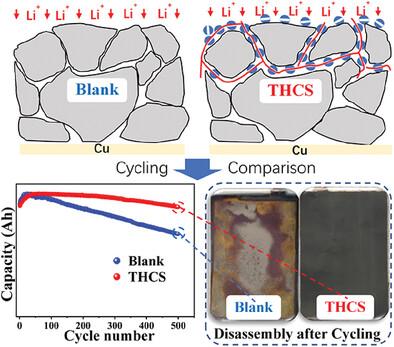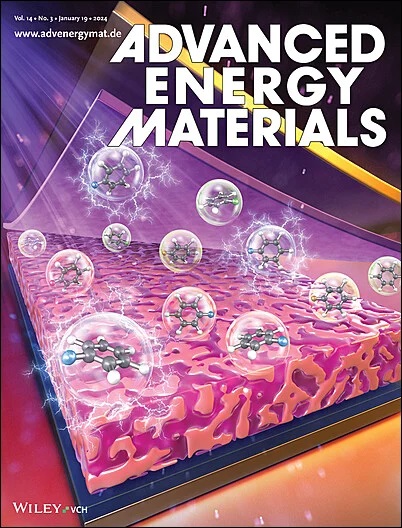Design of Gradient Porosity Architecture with Through‐Hole Carbon Spheres to Promoting Fast Charging and Low‐Temperature Workable Lithium‐Ion Batteries
IF 24.4
1区 材料科学
Q1 CHEMISTRY, PHYSICAL
引用次数: 0
Abstract
The reduced surface porosity of highly compacted graphite anode after calendering is one of the major obstacles restraining the fast‐charging capability and low‐temperature adaptability of lithium‐ion batteries. In this work, through‐hole carbon spheres (THCS) synthesized by coaxial electrospinning and the following template sacrifice method are employed as a pore‐forming agent on graphite surfaces for the first time. The established gradient porosity architecture endows graphite anode with interconnected conductive networks and abundant Li

利用通孔碳球设计梯度孔隙结构,促进锂离子电池的快速充电和低温工作性能
压延后高度致密的石墨负极表面孔隙率降低是制约锂离子电池快速充电能力和低温适应性的主要障碍之一。本研究首次采用同轴电纺丝法合成的通孔碳球(THCS)作为石墨表面的孔隙形成剂。已建立的梯度孔隙结构使石墨负极具有相互连接的导电网络和丰富的 Li+ 传输通道。因此,THCS 袋式电池具有快速充电能力(5 摄氏度时充电效率为 49.2%)、卓越的循环稳定性(1 摄氏度时循环 500 次后容量保持率为 96%)和低温适应性(-10 摄氏度时具有高抗镀锂能力)。相比之下,在相同的测试条件下,空白袋电池出现了严重的镀锂行为。相信这种简便且可扩展的梯度孔结构制造技术将成功促进商用锂离子电池的快速充电能力和低温适应性。
本文章由计算机程序翻译,如有差异,请以英文原文为准。
求助全文
约1分钟内获得全文
求助全文
来源期刊

Advanced Energy Materials
CHEMISTRY, PHYSICAL-ENERGY & FUELS
CiteScore
41.90
自引率
4.00%
发文量
889
审稿时长
1.4 months
期刊介绍:
Established in 2011, Advanced Energy Materials is an international, interdisciplinary, English-language journal that focuses on materials used in energy harvesting, conversion, and storage. It is regarded as a top-quality journal alongside Advanced Materials, Advanced Functional Materials, and Small.
With a 2022 Impact Factor of 27.8, Advanced Energy Materials is considered a prime source for the best energy-related research. The journal covers a wide range of topics in energy-related research, including organic and inorganic photovoltaics, batteries and supercapacitors, fuel cells, hydrogen generation and storage, thermoelectrics, water splitting and photocatalysis, solar fuels and thermosolar power, magnetocalorics, and piezoelectronics.
The readership of Advanced Energy Materials includes materials scientists, chemists, physicists, and engineers in both academia and industry. The journal is indexed in various databases and collections, such as Advanced Technologies & Aerospace Database, FIZ Karlsruhe, INSPEC (IET), Science Citation Index Expanded, Technology Collection, and Web of Science, among others.
文献相关原料
| 公司名称 | 产品信息 | 采购帮参考价格 |
|---|
 求助内容:
求助内容: 应助结果提醒方式:
应助结果提醒方式:


